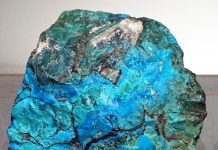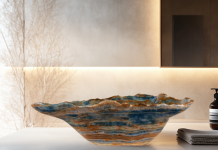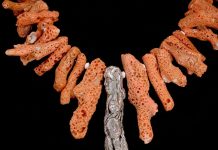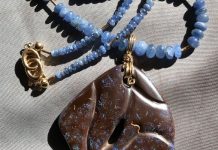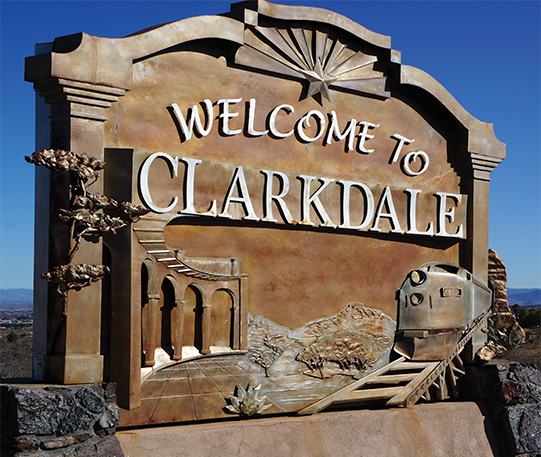
By Helen Serras-Herman
The most remarkable, rich collection of copper art is a hidden treasure found in the small town of Clarkdale, in north-central Arizona. The Copper Art Museum, which opened in 2012, celebrates the mineral symbolized by a copper star in the center of Arizona’s state flag.
There is no question that copper mining has been a huge contributor to Arizona’s heritage and wealth since the 19th century, along with its by-products of gold, silver, and molybdenum. It was mined by underground methods until the early 20th century, at which time open pit mining in the towns of Morenci, Bisbee, Bagdad, Ajo, and Globe became more profitable.
Clarkdale is a town in Yavapai County with a population of just over 4,000 residents. It was founded in 1912 and was mainly a smelting town, serving the town’s company smelter, which was processing ore from 1913-1958 from the nearby United Verde copper mine in Jerome owned by William A. Clark, known as “America’s Copper King.”
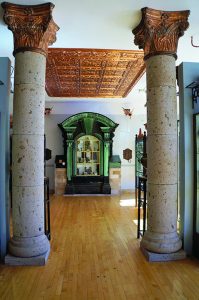
Clarkdale was the first master-planned community in Arizona. That means it was designed and built from a unified plan and was not a haphazard out-growth of a miner’s camp. The community featured paved streets; brick homes of quaint architectural styles; modern plumbing, sewage, and electricity; schools; and the landmark gazebo at Town Park. In 1998, the original town site, consisting of 387 homes and buildings, was placed on the National Register of Historic Places.
Pivotal Place
Clarkdale sits at an elevation of 3,545 feet, at the center of historic U.S. Route 89A, and rests along the constantly flowing Upper Verde River. The town is situated within an hour’s drive from the most scenic landscapes of northern Arizona – Flagstaff, the Grand Canyon, and the Red Rocks of Sedona – and is considered the “Gateway to Sycamore Canyon Wilderness Area”. The historic community of Jerome is only four miles to the southwest, the Tuzigoot National Monument less than two miles to the east, and the town of Cottonwood is only two miles to the southeast. Lodging and dining options are plentiful in Cottonwood.
Today the town of Clarkdale is mostly a destination for visitors riding the Verde Canyon Railroad, a passenger excursion heritage railroad that runs between Clarkdale and the abandoned train depot of Perkinsville. But the area’s most recent attraction addition, the Copper Art Museum, may overshadow even the ever-popular train ride.
The Copper Art Museum
The Copper Art Museum is housed in the historic former high school building, which was built in a Spanish-colonial Revival style after a $100,000 bond was approved by voters in 1927 and was immediately paid off by the United Verde Copper Company. The school was operational from 1928 to 1960, after which time it sat mostly vacant and in a state of disrepair. That is until 2002, when it was purchased to become the home of the Copper Art Museum. It required major renovation to restore the building to its original glory.
Visitors are greeted at the entrance by a triptych, shrine-like exhibit titled “Copper, the World’s Most Beautiful Metal.” The exhibit also reveals the museum’s objective, which is to showcase every form of copper art man has created. The primary categories of copper art featured in the museum are fine art: with aesthetically pleasing artifacts created with the purpose to be admired; decorative art: beautiful and usable objects; and applied art: plain and functional objects creatively decorated after their original purpose.
Further examples of copper art are methodically exhibited in separate areas of the museum such as Military Art, which includes more than 525 pieces of WWI brass artillery shell casings known as “Trench Art.” This genre of art is defined as a type of folk art including objects hand-tooled by soldiers during various military conflicts.
Brass is an alloy of copper and zinc, in contrast to bronze
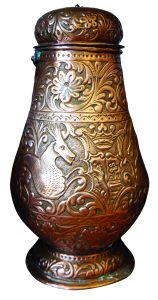
which is an alloy of copper and tin. In the Art & Architecture room, works used to embellish buildings and homes, such as ceiling panels, vases and fine art, fill the space. I found this gallery to be absolutely stunning with several copper ceiling panels and copper column capitals, adding opulence to a room full of plaques, vases, and copper figures. Decorative copper ceiling tiles also feature intricate designs of scroll work, with rich textures in solid copper.
Everyday and Artistic Representation
Religious art represented by statuettes, ceremonial artifacts, crucifixes, and icons fill another room of the museum, and the Cooking Room is an entire room full of cookware, wrought iron displays, and a beautiful stove, or simply a cook’s dream kitchen.
Further into the museum is the Drinking Room, which showcases copper beer steins and wine jugs dating to the 1400s. Nearby is the Distillery & Winery room with copper vessels and tools used for making wine and beer. Even the hallways are full of displays, artifacts, and information.
The Information Room, which is adjacent to the reception area, tells the story of copper, its history, and affinities. Through history and mythology, lore and legends, museum visitors learn about copper and why Venus – the planet and the goddess – and women all share the same symbol as copper. The museum displays an illustration of the Roman myth about Venus (the equivalent of Aphrodite, the Greek goddess of love), who was born from foam of the sea, stepped on a seashell, and then came ashore on Cyprus. Just as was portrayed in the painting “The Birth of Venus” by Renaissance artist Botticelli, it has become the museum’s emblem.
Cyprus is known as the “island of copper,” and is home to the Skouriotissa Mine, which has been producing copper for more than 6,000 years. Miners there were known to fashion tools from native deposits, and the mine is still producing today, although at somewhat of a recession. The very word “copper,” or “Kupros,” is derived from the Greek word for the island “Kypros.”
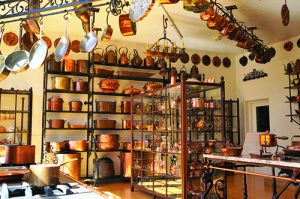
For gem and mineral lovers, there is a wonderful mineral cabinet in the Information Room of the Copper Art Museum. It contains mostly copper-related minerals such as chrysocolla, azurite, turquoise, malachite, and natural copper specimens. Also featured is a specimen of “Apache gold,” which is the trade name for a unique metallic rock of chalcopyrite in jet-black chlorite schist, found only in the “Big Hole” of the United Verde mine in Jerome. The name chalcopyrite comes from the Greek “khalkos” (copper) and pyrite.
Humble Beginnings
As per the museum’s official mission statement, they strive “to identify Arizona as the Copper State using artwork as the evidence, and to present the world’s most beautiful metal by acquiring, preserving, educating and displaying works of coppersmiths from around the world”. Furthermore, the vision is “to inspire visitors and create memories about the Copper State that will never be forgotten.” I have to concur that the depth and breadth of the collections, as well as the well-constructed educational exhibits with graphics and flat-panel TVs playing videos, will leave you in awe.
The first question that comes to mind as one starts going through the galleries is, how did this all start? The spark of an idea for this museum dates to 1958, when John and Patricia Meinke, residents of Minnesota, saw several copper molds in an antique shop. They were simply captivated by what they saw.
When Pat later opened her own small antique shop, she started focusing on and collecting copper items that would eventually become a massive collection, much of which is displayed at the museum. The couple eventually closed the shop, and between 1970 and 2003 were copper dealers exhibiting at antique shows around the country. They obtained copper items from the U.S. and Europe. In 1978, their son, Drake, joined the business and started his own collection. He is now the museum’s curator and the one who welcomed us at the museum, eager to share the museum’s story.
He pointed to the copper footprints embedded in the floor that follow a sequential path through the exhibits and allow visitors to start the tour on their own.
A Celebration of Copper
Over the years ,the family’s collections grew and, like so
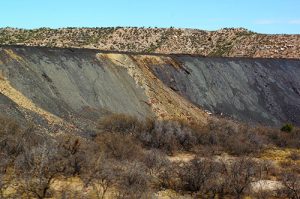
many collectors, the Meinkes’ envisioned a place to share their love for copper with the public. In 2000, they began looking for the right place for the museum. The location had to have roots and connection to copper, and Arizona was easily chosen, as it is the largest copper producer in the country, and therefore called the “Copper State.” Copper serves as the official state metal of Arizona and is one of the five Cs of Arizona’s economy: copper, climate, cattle, cotton and citrus.
Although many Arizona towns could have been in the running, Clarkdale fit the profile best, as its entire existence was due to copper. Ironically, even though all the town’s residents worked for the copper industry at one time, all of the copper was exported and eventually used by others, and residents never saw any of the metal.
The Copper Art Museum is an official Arizona Centennial Legacy Project. Since the museum’s opening, its board and curators have been further collecting copper artifacts and adding items in the cases. The collection includes more than 5,000 works of copper art and architecture, with emphasis on Western European and Northern American. Speaking with Monica, one of the docents at the museum, we learned that some of the pieces are restored and highly polished, while others are left in their dark brown stage. It’s fortunate that very little green oxidation occurs in Clarkdale, due to the low humidity levels, and very little up-keeping restoration is required.
I also inquired of Monica about the stunning copper wine jug featured on the museum’s flyer, which is embellished with decorative figures, animals, leaves, and flowers, very representative of the period. She explained that it is a wine pitcher that dates to the 17th century and is from northern Italy, the wine region of Tuscany. We had to go back, look at it one more time, and photograph it. It is modestly displayed on a shelf along with many other pitchers, part of a bountiful display with churns, urns, and pails, all part of the Drinkware Collection.
This is a world-class museum, worthy of being on Washington D.C.’s National Mall with all the other famous Smithsonian museums. Purposely located in a small town, it is definitely not provincial. The Copper Art Museum is located at 849 Main Street in Clarkdale and is open daily from 10 a.m. to 5 p.m. For more information, visit www.copperartmuseum.com
The Verde Canyon Railroad
As was mentioned earlier, the Verde Canyon Railroad is also a popular attraction in this area. It runs on the same tracks ordered to be built by William Clark for his mining operations, connecting the copper smelter in Clarkdale and the copper mines in Jerome. The railroad itself was owned by the Santa Fe Railway and was operational between 1912 and 1988, at which time it was purchased by the Clarkdale Arizona Central Railroad, and turned into a passenger touring attraction in 1990.
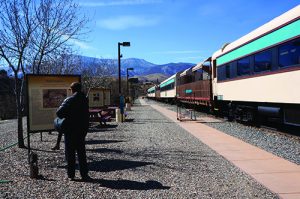
That is where we started our two-day excursion. Since we had limited time, I had made advance reservations online for the Verde Canyon Railroad (https://verdecanyonrr.com/). Offered are first class and coach class in fully restored vintage cars, and all passengers can access the shaded open-air viewing cars. The first class cars have large panoramic windows, spacious accommodations and lunch is included, all good reasons to chose this option. Most days the train departs at 1 p.m., but there are several special options.
Arriving early at the Verde Canyon Railroad, you’ll find the train depot is calm until hundreds of passengers flood the station shortly before the train departs, reminiscing bygone times of bustling train depots. However, there is plenty to do while you wait for departure.
Along the 1/4-mile loading platform, next to the parked train, there are wonderful interpretive signs, or storyboards, with a plethora of information and photos providing details about the history of the area, railroad lore, the historic locomotives, and the fauna and wildlife that visitors may encounter on this sightseeing adventure, many with a twist of humor. I loved the “Travelling Salesman” board featuring the story of the wild burros, and the “Canyon Dwellers with Short Term Leases” about the coyote and the elk.
Renovation and Preservation
For more area history of the past 100 years and artifacts, head to the Verde Canyon Railroad museum named the John Bell Museum, just steps from the platform. It is housed in a renovated boxcar, and artifacts range from arrowheads to mining lamps, 1880s-1900s train plates and spikes, vintage suitcases, telegraph crossbars and insulators, and a beautifully crafted model of the historic train station. Also on display is a medicine bag that was located in Jerome’s United Verde Hospital, used to assist the many miners and railroaders that worked in this small mining town, as well as an array of medicine bottles excavated from the present depot site.
Information boards also contain details about the Native
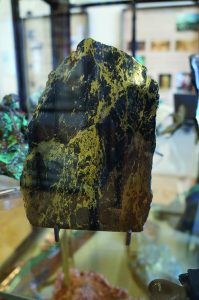
Americans of Verde Valley, the Sinagua Indian ruins, and cliff dwellings seen along the train ride, as well as information about early ranching in the Verde Valley, among other things.
And if you still have time, there is a packed gift shop for your memorabilia and book needs, and the Copper Spike café for your savor needs.
The four-hour train excursion takes visitors on a 20-mile journey through the Verde Canyon wilderness. It is part of the original 38-mile standard gauge railroad running from Drake to Clarkdale, financed by Senator and mine owner William Clark. The markers from 38 to 18 are identified by the mileposts along the route.
Mining Memories Aplenty
Soon after departing the station, the train passes a “mountain” of slag covering about 40 acres. This is the old slag dump, a remnant and reminder of the mining era. Slag was the smelter’s by-product material left behind after the desired metal was separated (smelted) from the ore. Slag is usually a mixture of metal oxides and silicon dioxide, and smelting copper is designed to remove the iron and silica that occurs in these ores. Slag was channeled out of the furnace in a molten state and water was poured over it, forcing a rapid cooling to take place, creating the hard, glassy material. The rusted iron pipes that carried the slag are still visible today.
As the train inches through rugged canyons, views of spectacular high-desert rock faces adorned with cactus and agave and the world-famous red rock buttes and pinnacles of Sedona come into focus. Next, the train follows the canyon floor through the rich riparian area beside the Verde River, where the green rippling, muddy waters reflect the river’s name given by the Spanish explorers, before it climbs back up almost 500 feet to the towering walls of Sycamore Canyon.
The beautiful cottonwood trees, willows, and sycamores are mixed with desert juniper and the desert’s iconic mesquite trees and cactus that change with the seasons, from the blooming spring colors to the brightly-colored fall foliage and stark winter beauty.
Honoring the Sinagua People
At the midway point, the train reaches the forsaken train depot of Perkinsville, still part of the Perkinsville Ranch, where the train makes a U-turn and starts its return voyage. Upon the return trip, the train passes close by the ancient Sinagua cliff dwellings that date between 1100 and 1400 A.D., still standing sentinel on the towering cliffs and a testament to the people who lived here long, long ago.
There is a guide aboard the train that shares the history of the area during the train ride, and every time there is a special scenic point, he alerts passengers to watch for it or get out to the open-air car to take a closer look and photograph. The train passes a couple of elegant bridges built on sturdy trestles that span the gorges. Those are truly spectacular moments when visitors can see the entire length of the train as it curves over the bridges and hugs the gorges. Lastly, the train comes to a 680-foot, man-made tunnel blasted through solid rock, and passengers are warned that complete darkness is upon them for a few moments until the train gets through the tunnel and back out to the Arizona sunshine.
Rich and diverse wildlife, reportedly including more than 900 animal species, may be witnessed during the journey.
A wonderful publication “Rail,” full of data and photos of local history, is also part of the train ticket.
That is why the Verde Canyon Railroad is one of the most popular Arizona attractions year-round.
Two additional places to visit while in the Clarkdale area is the Clarkdale Historical Society & Museum (www.clarkdalemuseum.org), and Jim & Ellen’s Rock Shop (www.jerockshop.com) in the historic Old Town of Cottonwood. A true rock shop filled with everything from high-quality identified mineral specimens, many from Arizona and local collecting sites, to Native American pottery and jewelry, and color metal ornaments. The owners, Jim and Ellen, are rockhounds and lapidaries and very knowledgeable. Definitely worth a visit!
Helen Serras-Herman, a 2003 National Lapidary Hall of Fame inductee, is an acclaimed gem sculptor and gemologist with over 36 years of experience in unique gem sculpture and jewelry art. Visit her website at www.gemartcenter.com and her business Facebook page at Gem Art Center/Helen Serras-Herman.



